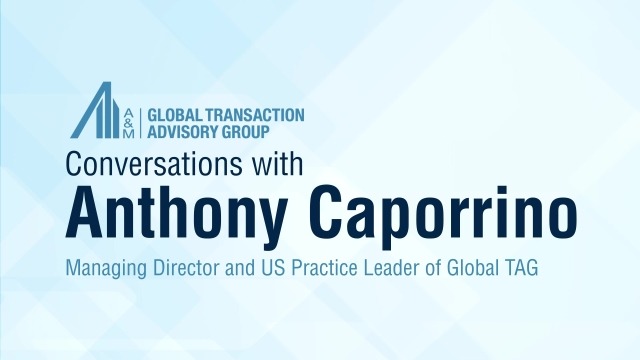What M&A Dealmakers Need to Understand about the Current "Vortex of Volatility"
As featured in Intralinks on August 14, 2019
As the world becomes increasingly interconnected, businesses are facing pressures from many fronts. For this edition of the SS&C Intralinks Deal Flow Predictor, we spoke with Paul Aversano, who says there’s opportunity on the buy- and sell-side for nimble dealmakers with a global perspective. Paul is a managing director in Alvarez & Marsal’s private equity services practice and the global practice leader of the firm’s Transaction Advisory Group, based in New York City.
For over 25 years, Paul has specialized in leading both buy-side and sell-side financial accounting due diligence for complex public and private company transactions, as well as transactions in the capital markets. A former Big Four partner, U.S.-certified public accountant, and frequent guest on Fox Business Network, Bloomberg Businessweek Radio, and many other broadcast and print media publications, Paul leads the group’s global efforts in the cross-border delivery of services to private equity, sovereign wealth, family office and strategic buyers.
Intralinks: Paul, you talk about dealmakers having to navigate a “vortex of volatility.” What do you feel are the key challenges that make up this vortex?
Paul Aversano: I have been engaged in M&A for over 25 years, and I can truthfully say that I have never seen as many variables driving the markets as we are seeing right now, nor the current levels of interconnectedness. On a macro level, we are dealing with an increasingly global economy and everything seems to impact everything else. As an example, a year ago the Turkish lira experienced a crisis, which in turn sent the U.S. stock market down. This just proves that the world is an increasingly global place.
Talking about M&A, there are some inherent pressures dealmakers must face. There are the record-high valuations, coming in at 11x multiples. These valuations could in turn create challenges when it comes to selling these assets, possibly in a down market. Then there is the record level of dry powder in the system, which Prequin in its latest estimate puts at $2 trillion, with over half of that sitting with private equity. Another factor is the large number of new market entrants competing for the same assets. Here I am thinking of sovereign wealth funds, family offices, traditional limited partners to PE [private equity] funds … all players who have traditionally allocated capital to private equity funds but are now investing in their own right.
But that is not all that dealmakers have to contend with?
The risks of higher interest rates and inflation, global currency fluctuations, the trade war between China and the U.S., technological disruption and digital transformation, Brexit, increasing levels of global protectionism, election cycles with the upcoming elections in the U.S. being the greatest concern, changing tax regimes and broader geopolitical risks in such places as North Korea, the Middle East and Venezuela. The list seems never-ending, and all factors put together to me create a perfect storm of factors that could potentially impact M&A, or what I have been referring to as a “vortex of volatility.”
Let’s dig a little deeper on some of the challenges you have highlighted. Talking about valuations, you note they are at a record high. Where do you see them developing from here?
I think they will continue to stay at relatively high levels for the foreseeable future. There is just so much capital needing to be deployed, and that will continue to maintain these high valuation levels. This pressure to deploy is driving certain types of M&A activity; for example, in the U.S. right now we are seeing over 50 percent of PE deals being done as secondary buyouts and over 60 percent as tuck-in or bolt-on acquisitions. The PE asset class is right now simply offering the highest returns and continuing to attract record levels of capital for investment.
Turning our attention next to geopolitical issues, are they really new, or are these in fact issues any generation of M&A practitioners have to deal with?
Every generation of dealmakers has geopolitical challenges to deal with. What in my mind has changed is the volatility of the rhetoric, which seems to be escalating. Between the U.S. and North Korea, we are clearly experiencing a war of words. Does this impact M&A directly? No, but it does create a feeling of uncertainty which does have an impact on both global debt and equity markets. There is also the risk of the unknown. One large, unforeseen geopolitical event can create havoc in the global markets.
Let’s now turn our attention to protectionism. How much is this a real factor preventing deals, and how much is this an issue that is merely attracting lots of media attention?
This is a real issue, largely concerning China, but also some others. On a recent trip to China, I was given to understand that Chinese businesses effectively see the U.S. market as shut, which is a stark contract to 2016 when we saw Chinese bidders in pretty much every situation. Yes, there is the issue of capital outflow restrictions that have had somewhat of an impact, but I feel strongly that the lack of Chinese bidders for U.S. assets is largely driven by increased regulatory scrutiny resulting from recent changes to CFIUS (Committee for Foreign Investment in the U.S.).
You have also highlighted the interconnectedness of many of these challenges. Keeping this in mind, how can dealmakers best prepare themselves? What structures and processes need to be in place to ensure successful transactions?
Value creation has been and will continue to be front and center, and a strong value creation plan, devised pre-acquisition, will be key. Financial engineering and increasing operation efficiencies will no longer be enough. Buyers will have to have a long, hard think about how they can really drive up revenues. The exact strategies will depend on the regions, but it means you need to be tactical about what our post-deal value creation plan is and have that in place pre-acquisition.
Every challenge brings opportunities with it for those willing to take a risk and consider the long term. Where do you see the greatest opportunities?
You are right. Chaos breeds opportunity. Yes, there are many challenges out there, but I would encourage buyers to assume the risk and find creative ways of dealing with it. When it comes to where the greatest opportunities lie, technology is the big thing and will be for years to come. The way I see it, every deal now is a technology deal, and every company needs a digital transformation strategy. Every company needs to have a long, hard think: Am I going to be a winner due to the digital transformation my industry is going to experience, in which case I will invest? Or am I in fact going to lose out – and here I am thinking in particular about the retail industry – and we therefore might want to exit and leave the field to someone else? These are big questions that businesses are going to have ask themselves.
Finally, Paul, can you give us your outlook on M&A for the near- to medium-term future?
Bullish, very bullish! The fundamentals are good, there is so much dry powder that deals will simply need to be done – there is no other way around it. Am I concerned about a crash? Not really. Unlike in the financial crisis when funding for deals from the traditional lenders dried up, the money is now coming from a huge range of new sources. Those funders too are sitting on huge amounts of cash that need to be deployed. The challenge will be developing that strong and sustainable value creation story and to be stringent in its execution.
Paul, many thanks for sharing your insights.
It has been my pleasure.





